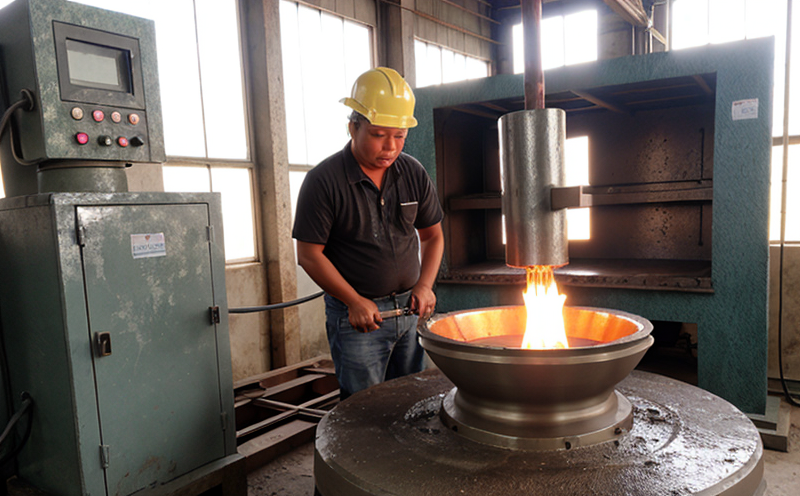ASTM A903 Magnetic Particle Testing of Cast Irons
The ASTM A903 standard specifies the procedures for detecting surface and near-surface discontinuities in cast iron parts using magnetic particle testing (MPI). This method is widely employed to ensure the integrity and reliability of cast iron components used in industrial manufacturing processes. The process involves applying a magnetic field to the component, which can be achieved through either electromagnetism or permanent magnets, followed by the application of magnetic particles that are attracted to areas where there are discontinuities.
The primary purpose of this testing method is to identify cracks, porosity, and other flaws that may affect the performance and durability of cast iron parts. The technique is particularly effective for detecting surface-breaking defects as well as near-surface imperfections that might not be visible through visual inspection or other non-destructive methods.
The process can be summarized in a few key steps: First, the component undergoes thorough cleaning to remove any dirt, grease, and oil. This ensures accurate detection of flaws. Next, the magnetic field is applied using either an electromagnet or permanent magnet. The intensity of this field must be sufficient to detect the smallest defects but not so strong as to cause demagnetization issues.
Once the magnetic field is established, a suspension of magnetic particles (usually iron oxide) in a liquid carrier is applied to the surface of the component. These particles are attracted to areas where there is a disruption in the magnetic flux due to discontinuities within the material. If defects are present, these disruptions cause the magnetic field lines to concentrate and form visible patterns or indications on the surface.
The visual assessment of the indications is critical. Technicians must be trained to interpret the patterns formed by the magnetic particles to determine whether they represent defects. The presence of false positives can often lead to incorrect conclusions, hence the need for skilled personnel. Once the inspection is complete, any remaining magnetic fields are neutralized.
ASTM A903 specifies detailed acceptance criteria that define what constitutes a defect and what does not. These criteria ensure consistency in the testing process across different labs and operators. The standard also provides guidance on the selection of appropriate magnetization techniques based on the geometry and size of the component being tested.
Why It Matters
The importance of ASTM A903 testing in industrial manufacturing cannot be overstated. In sectors such as automotive, aerospace, and heavy machinery production, cast iron components are crucial for structural integrity and performance reliability. Any defect or flaw can lead to catastrophic failures during operation, resulting in significant downtime, safety hazards, and increased maintenance costs.
By employing ASTM A903 testing, manufacturers ensure that critical parts meet the highest quality standards. This is particularly important for applications where cast iron parts are subjected to high stress levels or operate in harsh environments. The testing process not only enhances product reliability but also contributes to operational safety and extends service life.
In addition to ensuring compliance with industry regulations, ASTM A903 testing helps maintain a competitive edge by reducing the risk of failures that could compromise production schedules and customer satisfaction. It is an essential tool for quality management teams looking to implement robust inspection protocols that align with international standards.
Scope and Methodology
| Aspect | Description |
|---|---|
| Magnetic Field Application | The ASTM A903 standard specifies the use of either electromagnets or permanent magnets to generate a magnetic field. The intensity should be sufficient to detect defects but not so strong as to cause demagnetization issues. |
| Particle Suspension | A suspension of iron oxide particles in a liquid carrier is applied to the component's surface. This enables the particles to form visible patterns on the surface where there are magnetic flux disruptions due to defects. |
| Inspection and Interpretation | The technician inspects the component for visible indications of defects. Proper training and experience are crucial for accurate interpretation of these indications. |
The ASTM A903 standard also provides detailed acceptance criteria that define what constitutes a defect and how to proceed if such defects are detected. This ensures consistency in the testing process, reducing variability between different labs or operators. The standard further outlines appropriate magnetization techniques based on the component's geometry and size.
Industry Applications
- Aerospace: Ensuring the integrity of cast iron components used in aircraft structures.
- Automotive: Detecting flaws in engine blocks, transmission housings, and other critical parts.
- Construction Equipment: Inspecting excavators, cranes, and other heavy machinery for defects that could affect performance.
- Mining Machinery: Guaranteeing the reliability of mining equipment through rigorous testing.
| Industries | Components Tested |
|---|---|
| Aerospace | Airframe structures, engine parts |
| Automotive | Cylinder blocks, transmission cases |
| Construction Equipment | Excavator frames, crane components |
| Mining Machinery | Drill bits, conveyor systems |
The ASTM A903 testing method is versatile and can be adapted to suit various industrial applications. Its ability to detect surface and near-surface defects makes it an invaluable tool for ensuring the quality of cast iron components across diverse sectors.





